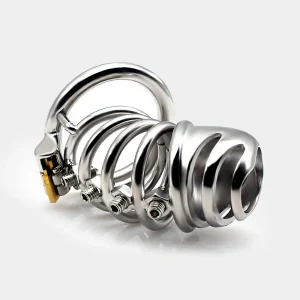How to Clean a Chastity Cage Effectively
Last Updated on July 14, 2025 by Nikita
Chastity play has gained popularity in recent years, and many men and their keyholders enjoy the sense of control and anticipation that comes with wearing a chastity cage. However, maintaining proper hygiene is crucial to ensuring a safe and enjoyable experience. Knowing how to clean a chastity cage not only preserves the device but also ensures personal comfort and health. Whether you’re wearing a chastity cage for a few days or committing to long-term wear, it’s essential to keep it clean and safe.
Why Is Cleaning a Chastity Cage Important?
Cleaning your chastity cage regularly is vital for several reasons:
- Hygiene: Sweat, urine, and natural bodily oils can build up in the cage, which may lead to unpleasant odors or even infections if not cleaned properly.
- Skin Health: Wearing a chastity cage for long periods without proper cleaning can cause skin irritation or rashes, particularly in sensitive areas.
- Device Longevity: Regular cleaning extends the life of your chastity device by preventing corrosion, scratches, or material degradation, especially if you’re using a metal cage.
- Comfort: A clean cage is more comfortable to wear, as buildup and residue can lead to discomfort or chafing over time.
How Often Should You Clean a Chastity Cage?
The frequency of cleaning depends largely on the type of chastity cage you’re wearing, how long you plan to keep it on, and your personal hygiene practices.
General Cleaning Schedule
- Daily Cleaning: If you’re wearing a fully enclosed cage or a cage with limited ventilation, it’s advisable to remove it daily or at least every other day for thorough cleaning. This is especially important if you’re uncircumcised, as cleaning under the foreskin is necessary to prevent buildup.
- Every Few Days: For those with an open-style cage (such as a birdcage design), you might find it easier to clean the cage without removing it entirely. You can rinse the cage under running water and use a gentle soap to clean the exposed areas. However, it’s still a good idea to remove the cage for a deeper clean every few days.
- Weekly Deep Cleaning: Even with a more open-style cage, you should still remove it at least once a week for a full clean, especially if you’re sweating a lot or engaging in physical activity. If your cage is made of materials like plastic, silicone, or metal, ensure you follow the manufacturer’s cleaning guidelines for safe and thorough cleaning.
Special Considerations
- Exercise or Sweating: If you exercise or sweat heavily, you should clean your cage more frequently. Sweat can cause the buildup of bacteria, leading to discomfort and odors.
- Long-Term Wear: For those in long-term chastity, a schedule of cleaning every few days (while removing the cage) will help keep everything hygienic and comfortable. Some keyholders set regular unlocking schedules for cleaning as part of the long-distance play.
Shop the Best Male Chastity Devices 、Bondage from Anesidora
-
Product on sale
 Anesidora Metal Chastity Cage$62.99 – $71.99
Anesidora Metal Chastity Cage$62.99 – $71.99 -
Product on sale
 Anesidora Pink Chastity Cage$30.59 – $40.49
Anesidora Pink Chastity Cage$30.59 – $40.49 -
Product on sale
 Anesidora Black Chastity Cage 4 Sizes$31.49 – $35.99
Anesidora Black Chastity Cage 4 Sizes$31.49 – $35.99
Cleaning Techniques for Different Types of Cages
Different chastity cages require different cleaning techniques based on their materials and design. Let’s break it down based on the most common types.
1. Metal Chastity Cages
Metal cages, typically made of 316LVM surgical steel, are durable, hygienic, and easy to clean. They can also be sterilized in boiling water or with an autoclave (if available).
Cleaning Steps:
- Daily: Rinse the cage with warm water and soap. Use a soft cloth or a toothbrush to scrub away any residue.
- Weekly Deep Clean: You can sterilize metal cages in boiling water. Just ensure that the lock and any non-metal components are waterproof before boiling.
- Drying: After cleaning, dry the cage thoroughly using a towel or air dryer. For a more thorough drying, you can use a hairdryer on a cool setting to ensure no moisture remains inside.
2. Plastic or Silicone Cages
Plastic or silicone cages are lightweight and more comfortable but require more careful cleaning since they can retain odors or bacterial buildup.
Cleaning Steps:
- Daily: Rinse the cage with warm water. Use a gentle soap or antibacterial wash to clean all surfaces. For a deeper clean, use a cotton swab or pipe cleaner to get into the small spaces.
- Weekly: Use an antibacterial solution to give the cage a deep clean, and check for any signs of wear or deterioration in the material.
- Drying: Dry these cages thoroughly to avoid moisture buildup, which can lead to odor or infection. A towel or air drying works well, but avoid putting them in the dryer.
3. Open-Style Cages
Open-style cages with large gaps and vents are designed to be more breathable, which makes them easier to clean. You can often clean them without removing the cage entirely.
Cleaning Steps:
- Daily: If you don’t want to remove the cage, simply rinse it under water, making sure to clean the areas between the bars and rings. Use a gentle soap and a toothbrush or cloth to scrub away any buildup.
- Every Few Days: It’s a good idea to fully remove the cage every few days for a more thorough clean, especially if you sweat a lot or if you’re experiencing any discomfort.
Tips for Keeping Your Chastity Cage Dry
Moisture and humidity can lead to irritation or unpleasant smells. To keep your chastity cage dry:
- Use a Hairdryer: After cleaning, use a hairdryer on a cool setting to dry the inside of the cage, especially if it’s made of metal. This helps ensure no moisture remains trapped.
- Change into Clean Underwear: After cleaning and drying the cage, make sure to wear clean underwear to prevent any moisture buildup from sweat or natural body oils.
- Avoid Wet Environments: If possible, avoid prolonged exposure to wet or damp environments while wearing the cage. This reduces the chances of infection and skin irritation.
Common Mistakes to Avoid
- Over-Cleaning: While it’s essential to clean your chastity cage regularly, over-cleaning, especially with harsh chemicals, can degrade the material or cause unnecessary wear.
- Not Drying Properly: Moisture can cause bacteria to thrive, so ensure that both the cage and your skin are thoroughly dried after each cleaning session.
- Ignoring Buildup: Any visible buildup of residue, odor, or irritation should be addressed immediately. Don’t ignore these signs, as they could lead to infections or skin irritation.
Conclusion
Cleaning your chastity cage is a simple but essential part of the chastity experience. Whether you’re using a metal, silicone, or open-style cage, regular cleaning helps maintain hygiene, prevent infections, and ensure comfort during long-term wear. Always follow manufacturer guidelines and be proactive in your hygiene routine, whether you’re cleaning every day, every few days, or weekly.
With the right cleaning routine, you’ll be able to enjoy your chastity play without concerns about discomfort or hygiene. Keep it clean, and your chastity experience will be smooth, safe, and enjoyable.
For More Please Read:







